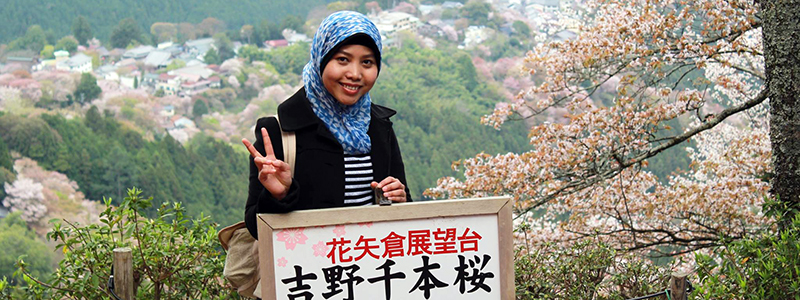Dini Wahyu Kartika Sari さん
2016年度(博士) Gene and Regulation Research Laboratory
Lecturer and Researcher at Aquaculture Study Program, Universitas Gadjah Mada, Head of Master Study
For tomorrow’s leaders in science and technology, outgrow your limits in NAIST!

As an academic, I should have first obtained a doctorate, which enabled me to continue pursuing a decent career in the higher education environment. My academic path began with a NAIST pre-screening invitation in January 2012, after which I was approved as a NAIST student candidate. In the same year, I was fortunate to get a scholarship from the Hitachi Scholarship Foundation, allowing me to enroll as a student at NAIST immediately.
NAIST was my first choice because of its outstanding reputation for research-based education. Professors at NAIST have a reputation for publication in the world's top journals, and NAIST is supported by sophisticated research equipment facilities. NAIST also has many excellent education programs, such as assigning students to international conferences, funding internships at several world-class universities, and inviting professors and students from partner universities to NAIST for Bio-Seminar or workshop agendas. Because of NAIST's extensive networks, I collaborated with colleagues from The University of California Davis, Kyoto University, and Harvard University during my studies.
At NAIST, I worked in the Gene Regulation Research Laboratory, where I researched the developmental biology of zebrafish under the supervision of Prof. Yasumasa Bessho and Assoc Prof. Takaaki Matsui. Throughout my doctoral course, I received extensive professional development. The morphology of the zebrafish embryo changes every moment. Its process is controlled by dynamic cellular signaling, but observing the dynamic cellular signaling was difficult at that time. I used confocal microscopes to watch zebrafish embryos alive. It is a live-imaging approach. I focused on somite formation, a prepattern of zebrafish body, in my project. I used a FRET biosensor to monitor the dynamics of the cellular signaling and successfully clarify a part of the mechanism of somite formation.
As expected, starting a new study is not easy. However, the supervision and encouragement from my professor and lab mates made it all worthwhile. My professor's motivational phrase that I'd never forget is "just enjoy science." Growing up in a supportive environment, having fortitude, and enjoying science, I successfully published three papers in top international journals due to my thesis research and collaboration.
Other things that make me feel at home in Japan are the hospitality of the people, the culture, and the spectacular scenic beauty. Japanese people are amiable, so wherever I go, I feel safe and comfortable. Japanese culture is also very interesting, various kinds of festivals are held year-round. I enjoyed the four seasons in Nara. There is Sakura Matsuri (Cherry Blossom Festival) in spring. Nara Tokae Lantern Festival, where thousands of candles are lit in the Nara Park area, forms an emotional natural landscape in summer. Beautiful and colorful scenery when the leaves turn yellow, orange, or red in autumn. At the Yamayaki Festival, the fire on Mt. Wakakusa illuminates the night sky in winter.
After completing my doctoral studies at NAIST, I began my academic career at Universitas Gadjah Mada. I use the knowledge and skills I gained at NAIST in molecular biology to further my research and teaching at Universitas Gadjah Mada. After graduation, I became an official member of the Indonesian NAIST Alumni Association (INAA), and my networks continued to expand. This organization has established an alumni network and maintains excellent communication and collaboration with NAIST, particularly in research and academics, such as research collaboration, visiting professors, and actively recruiting talented students.
For future talented students who have a dream to become tomorrow’s leaders in science and technology, outgrow your limits in NAIST!
(2022年10月掲載)
 奈良先端科学技術大学院大学
奈良先端科学技術大学院大学